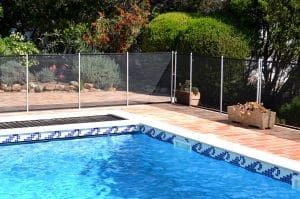 Made from polypropylene or welded metal, deer fencing is traditionally used to exclude or contain game such as deer or elk. What many fail to realize is that deer fence installation can do so much more than that. Here are 10 practical deer fence uses that might surprise you.
Made from polypropylene or welded metal, deer fencing is traditionally used to exclude or contain game such as deer or elk. What many fail to realize is that deer fence installation can do so much more than that. Here are 10 practical deer fence uses that might surprise you.
As Vineyard or Orchard Fences
Deer will eat all the ripe fruit off of trees if you allow them to. An 8-foot high metal deer fence will make for a tough and long-lasting barrier.
As Dog Fences
Deer fences made from metal, polypropylene, or a combination of both, are strong enough to keep your dog safe. The recommended fence height should be between 3 to 7 feet, depending on the dog’s size and agility.
As Swimming Pool Fences
There are homeowners who want to use deer fencing to fence their swimming pool; this is fine as long as it meets local pool fencing codes. Generally, a 4-foot high fence with mesh openings no bigger than 1.5 x 4 inches is allowed. Deer fences are a more economical alternative to decorative metal fences.
As Temporary Bed Fencing
If you have growing trees and shrubs in need of protection from hungry deer during winter, a temporary enclosure is just what you need. Install deer fencing on removable posts using ground sleeves that sit evenly on the ground. Put it up in the fall and take it down come springtime.
As Garden Fences
A 3 to 4-foot high deer fence can keep most critters away from your garden. Install a taller fence if you’re experiencing both critter and deer problems.
As Cat Fences
Deer fence is just as effective in keeping cats within a designated area. For hyperactive feline friends, a post extender can be installed at a 45-degree angle pointing inward to deter them from climbing over the fence.
As Leaf Catchalls
Lightweight polypropylene deer fencing can be placed over groundcover and ornamental plants to protect them from falling leaves. The fence can be eventually rolled up and emptied into a leaf pile.
As Deer Rub Protection
Bucks rub on trees to remove the velvet coating that forms on their antlers. They also do this to mark territory, work off aggression, or intimidate other bucks. This strips off the bark and injures the tree. In order to prevent this, wrap the base of each tree with deer fencing and secure it with cable ties.
As Rodent Deterrents
Rodents can cause a lot of costly damages to yards and farms. Their teeth can chew on just about anything – except steel. Metal deer fences with a small grid design prevent rodents from fitting or gnawing their way through.
Keep rabbits out of your property by installing a two-foot metal deer fence around the entire perimeter. Peg it down to the ground with ground stakes. The nice thing about this is that while it’s easy enough for you to step over the fence, rabbits won’t be able to jump over or wriggle their way underneath it.
For groundhogs, installing a 7.5-foot high polypropylene deer fence around the perimeter is recommended, in addition to a 3-foot high chew protection barrier. The material has just enough “give” to keep groundhogs off balance; they won’t be able to go all the way up.
As Trellises
Lightweight metal or polypropylene deer fencing material can be stretched in between posts to function as custom trellises for climbing plants in indoor and outdoor gardens. Strengthen the fence by adding a cable at the top to support the weight of growing plants.
Straight Shooter Game Fencing specializes in high-tensile game fencing. We work with property owners throughout the US to provide the best deer fence installation, service, and fencing materials at competitive prices. Get in touch with us to know more.
